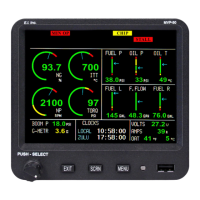2.1 Important Information and Initial Check Out:
A. The installer and aircraft owner must read the Warranty/Agreement before starting the
installation. There is information in the Warranty/Agreement that may alter your decision to install this
instrument. If you do not accept the terms of the Warranty/Agreement, do not install this instrument.
B. If you are not an FAA Certified Aircraft Mechanic familiar with the issues of installing engine
and aircraft instruments, Do not attempt to install this instrument. The installer should use current
aircraft standards and practices to install this instrument (refer to AC 43.13).
C. Check that any necessary FAA Approvals are available for your aircraft before starting the
installation. DO NOT install the MVP-50T in an aircraft that has been configured as a commuter.
D. Read the Installation Instructions entirely and resolve any issues you may have before starting the
installation. This may eliminate any delays once the installation is started.
E. Inspect the contents of this package prior to installation. If the MVP-50T system is to be installed into
a certified aircraft, check that the Model Number listed on the TSO label incorporates the Aircraft ID
for which it is to be installed. Each MVP-50T display is configured for a specific aircraft and should
only be installed in that aircraft.
F. Do not install a non-certified MVP in a certified aircraft. A certified MVP lists the applicable TSO
numbers at the bottom of the Model Label.
G. Before starting the installation make sure the instrument will fit in the location you intend to install
it without obstructing the operation of any controls. CFR 23.1321(a) states, “Each flight, navigation,
and power plant instrument for use by any required pilot during takeoff, initial climb, final approach, and
landing must be located so that any pilot seated at the controls can monitor the airplane’s flight path and
these instruments with minimum head and eye movement.” AC 23.1311-1B provides one method (but
not the only method) of complying with this CFR. AC 23.1311-1B recommends a power plant instrument
be installed within a distance of 21" from the pilot’s visual centerline to the middle of the instrument. The
pilot’s visual centerline is a perpendicular line from the pilot’s eye to the instrument panel. In most aircraft,
installing the MVP-50T to the right of the Radio Stack would be acceptable. In some aircraft, the visual
centerline falls to the right of the Attitude Indicator.
If the power plant instrument cannot be installed within 8" of the pilot’s visual centerline, AC 23.1311-1B
recommends Master Caution and Warning Lights be installed. Installation of Master Caution and Warning
Lights is covered in this manual.
H. If this instrument is to replace an existing gauge in the aircraft, it is the installer’s responsibility to
move or replace any existing instruments or components in accordance with FAA approved methods and
procedures (see AC 43.13).
I. An Installation Checklist is provided to assist the installation of the MVP system. It does not replace the
instructions located in this manual.
9

